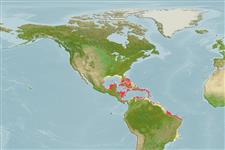Common names from other countries
>
Eupercaria/misc (Various families in series Eupercaria) >
Scaridae (Parrotfishes) > Scarinae
Etymology: Scarus: Greek, skaros = a fish described by anciente writers as a parrot fish; 1601 (Ref. 45335).
Environment: milieu / climate zone / depth range / distribution range
Ecologia
marinhas associadas(os) a recifes; intervalo de profundidade 2 - 25 m (Ref. 9710). Tropical; 33°N - 34°S, 98°W - 31°W
Western Atlantic: Bermuda, southern Florida (USA), and Bahamas to Brazil; throughout the Caribbean (Ref. 3802).
Length at first maturity / Tamanho / Peso / Idade
Maturity: Lm ?, range 17 - ? cm
Max length : 35.0 cm TL macho/indeterminado; (Ref. 9710); common length : 22.0 cm TL macho/indeterminado; (Ref. 3802); Idade máx. registada: 11 anos (Ref. 130677)
Espinhos dorsais (total) : 9; Raios dorsais moles (total) : 10; Espinhos anais: 3; Raios anais moles: 9. Juveniles and young adults dark olive above with 2 broad dark stripes: upper from tip of snout through eye to middle of caudal fin base, lower from chin through pectoral fin base to lower caudal fin base; white area above upper stripe continues around front of head above eye (Ref. 26938).
Found on bottoms with coral or rock (Ref. 13628). Juveniles often occur in association with Thalassia. Forms large feeding aggregations and feeds on plants. Sleeps in a mucus cocoon (Ref. 9710).
Life cycle and mating behavior
Maturities | Reprodução | Spawnings | Egg(s) | Fecundities | Larvas
Oviparous, distinct pairing during breeding (Ref. 205).
Robins, C.R. and G.C. Ray, 1986. A field guide to Atlantic coast fishes of North America. Houghton Mifflin Company, Boston, U.S.A. 354 p. (Ref. 7251)
Categoria na Lista Vermelha da IUCN (Ref. 130435)
CITES (Ref. 128078)
Not Evaluated
Ameaça para o homem
Reports of ciguatera poisoning (Ref. 30303)
Utilização humana
Pescarias: pouco comercial; Aquário: Espécies comerciais
Ferramentas
Relatórios especiais
Descarregue XML
Fontes da internet
Estimates based on models
Preferred temperature (Ref.
115969): 26.2 - 28.2, mean 27.4 (based on 664 cells).
Phylogenetic diversity index (Ref.
82804): PD
50 = 0.5000 [Uniqueness, from 0.5 = low to 2.0 = high].
Bayesian length-weight: a=0.01445 (0.00686 - 0.03044), b=3.03 (2.86 - 3.20), in cm Total Length, based on LWR estimates for this Genus-body shape (Ref.
93245).
Nível Trófico (Ref.
69278): 2.0 ±0.1 se; based on diet studies.
Resiliência (Ref.
120179): Médio, tempo mínimo de duplicação da população 1,4 - 4,4 anos (K=0.32; tm=1.5; tmax=11).
Fishing Vulnerability (Ref.
59153): Low to moderate vulnerability (33 of 100).
